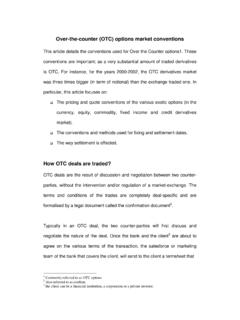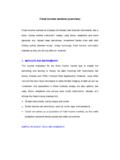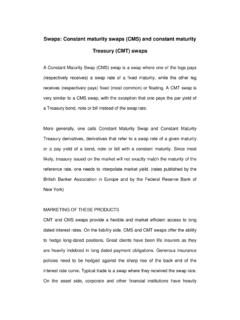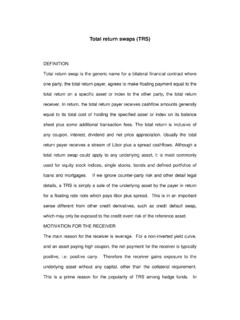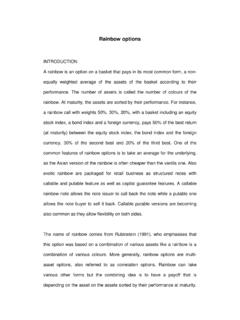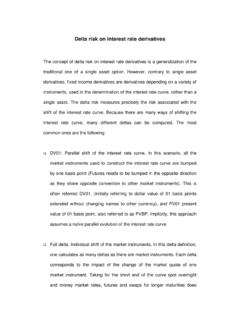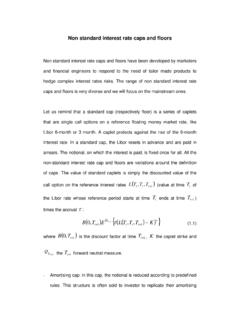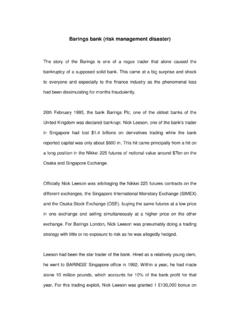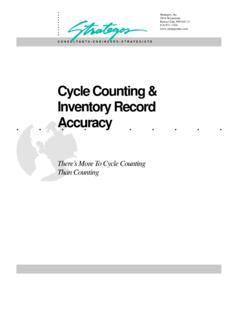Transcription of Accrued interest and day count conventions - Eric …
1 Accrued interest and day count conventions The terminology of Accrued interest originally refers to bond valuation, although it has been extended to swaps and more generally to fixed income securities. For a bond, it is the proportion of the coupon amount that a bond investor/trader pays on top of the clean price, when buying a bond. It is computed as the coupon amount times the fraction of this coupon period that has already passed. In order to compute the fraction of time, one has to refer to the day count conventions . These day count conventions determine how to financially measure time. Date count conventions are a very important element in the valuation of fixed income securities.
2 Taking the wrong convention can cost a substantial amount of cash as the size of the principal are usually quite big (several billions of dollars for big transactions). Day count conventions are rigorously defined in the 1991 definition of ISDA (See Master agreement). An interest rate corresponds to a given period of time, called the interest rate reference period. Day count conventions say that the interest (or coupon) amount between two dates is equal to the ratio of the number of days between the two dates over the number of days in the reference period time the interest (coupon) earned over the reference period: RDD*21 Where 1 Drepresents the number of days between the two dates (according to the day count convention ), 2 Dthe number of days between the reference period and Rthe reference rate (coupon) earned during the reference period.
3 Since the buyer of a bond get the next coupon (trading is cum dividend ), the price to pay for a bond jumps by the coupon amount just after the coupon date. Also, the bond seller looses her/his right to get the next coupon. The Accrued interest aims at quantifying (linearly) the bond seller financial loss. In order to get a smoother price, the trading industry quotes the bond price minus the Accrued intersest, referred to as the clean price. The cash price (also referred to as the dirty price, full price or invoive price) is therefore given by: Dirty price=clean price+ Accrued interest . Usuall day count fractions are the following: Actual/Actual.
4 Mainly used for swaps and government bonds. 30/360. (referred to as the bond basis as it is used widely by corporate bonds) Actual/360 (referred to as money market convention as it is used by most of the money market instruments) 1. Actual/Actual Day Counting Used for Treasury bonds and notes, it is the most intuitive of the day counting schemes. In this convention , the number of days between two dates is the actual number of days. For example, the number of days between February 23 and March 5 will be 10 in most years, and 11 in leap years. Similarly the number of days between January 15 and March 5 will be 49 in regular years or 50 in leap years.
5 Many Treasury bonds pay coupons on the 15th of the month. For a bond that pays coupons in January and July, the first coupon period would corresponds to 181 days or 182 for leap years and the second period to 184 days. In the case of an 8% coupon Treasury bond paying semi-annually (day count convention : actual/actual), whose previous coupon date was the January 15, the Accrued interest on March 5, would therefore be for a regular year: while it would be in leap year (see the table below) Field Value Formula Coupon Paying Date 15-Jan-02 Input Today 05-Mar-02 Input Number of Days 49 =(15-Mar-02 - 15-Jan-02 ) Next Coupon Date 15-Jul-02 =(15-Mar-02 - 15-Jan-02 ) Period Number of Days 181 Input Day count fraction interest 4% Input Payment *49/181 Table 1.
6 Case of a regular year Field ValueFormula Coupon Paying Date 15-Jan-00 Input Today 05-Mar-00 Input Number of Days 50=(15-Mar-00 - 15-Jan-00 ) Next Coupon Date 15-Jul-00=(15-Mar-00 - 15-Jan-00 ) Period Number of Days 182 Input Day count fraction interest 4%Input Payment *50/182 Table 2: Case of a leap year 2. 30/360 Day Counting Used for corporate bonds, Agency bonds, and all mortgage backed securities, the 30/360 day counting scheme was invented at a time that computer did not exist. To make computation easier, this convention assumes that all months are equal and have 30 days. Consequently all years have 360 days. This way, tables could be used to look up the value of Accrued interest .
7 In the 30/360 basis, the number of days between February 23 and March 5 is 12 days, even if it is a leap year. Moreover, the February month is in this convention a regular month with 30 days. Between two coupon dates for bond paying semi-annually, there is exactly 180 days between any succesive coupon dates. According to the Public Securities Association (PSA), the 30/360 day count fraction follows the following rules when calculating the number of days between any two dates. The number of days from M1/D1/Y1 to M2/D2/Y2 is computed according to the following procedure: 1. If D1 is 31, change D1 to 30. 2. if D2 is 31 and D1 is 30 or 31, then change D2 to 30.
8 3. If M1 is 2, and D1 is 28 (in a non-leap year) or 29, then change D1 to 30. Then the number of days, N is: N = 360(Y2 - Y1) + 30(M2 - M1) + (D2 - D1) 3. Actual/360 Day Counting Used for bank deposits money market rates like LIBOR (with the exception of Eurodeposits in pounds and Belgian Francs which are quoted actual/ 365), this convention is a mixture between the previous two. It assumes 360 days per year while taking the number of days between two dates to be equal to the exact number of days. Hence, in this convention , a regular year counts for 365/360 = , while a leap year for 366/360= Eric Benhamou1 Swaps Strategy, London, FICC, Goldman Sachs International Entry category: bond valuation Scope: Fixed Income Securities valuation Related articles: Bond.
9 1 The views and opinions expressed herein are the ones of the author s and do not necessarily reflect those of Goldman Sachs
